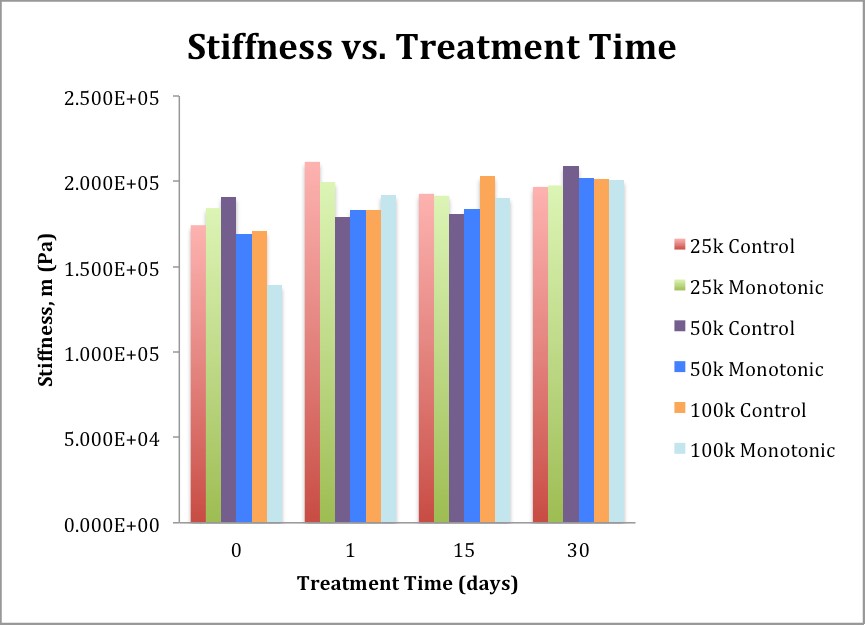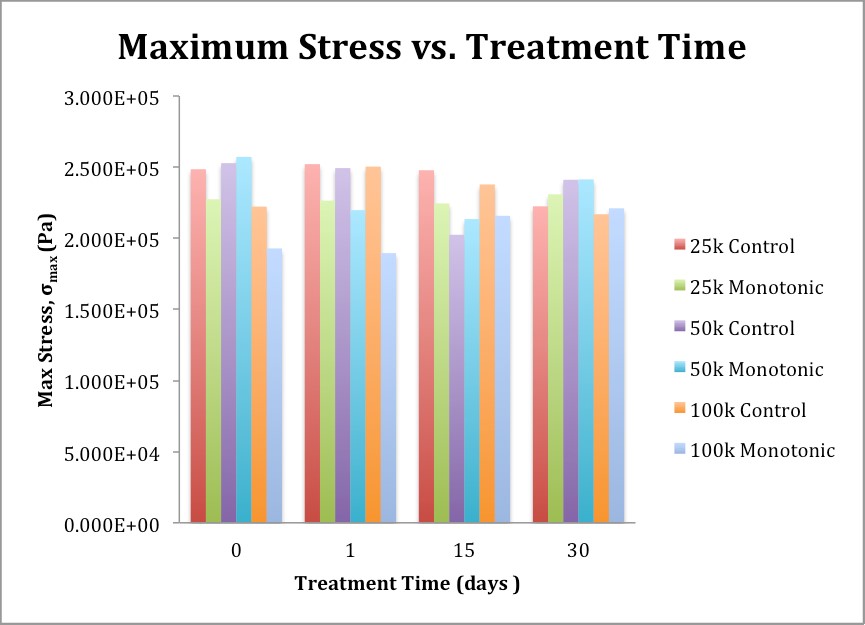Introduction: Elastin is a stable protein capable of enduring over a billion cycles under normal hemostatic conditions, and is an attractive material for tissue engineering applications[1][2]. Elastin stores strain energy, allowing arteries to expand and recover as blood is pumped from the heart. Glycation, where glucose molecules react with a protein or lipid, is associated with arterial aging and increased stiffness. During cyclic loading of materials, mechanical properties such as stiffness and maximum stress may change, thus altering the biomechanical integrity of a tissue engineering scaffold. This study examined the effects of glycation and extended cyclic loading on mechanical properties of isolated arterial elastin.
Methods: Porcine aortas were obtained from a local abattoir. Adherent tissue was removed and “dog-bone” shaped samples were cut with a custom die. Isolated elastin specimens were prepared using the method of Lu et al[2]. Specimens were placed in 5M glucose solution for 0 (control), 1, 15, or 30 days. Samples were cyclically loaded in tension using a custom-built material testing system[3], under displacement control at 1 Hz to a maximum displacement of 3mm. All tests were performed in PBS solution at 37°C. Samples were loaded for 25k, 50k, or 100k cycles and then monotonically tested in tension to failure at a strain rate of 0.05mm/sec. Stress (σ = load/initial cross-sectional area) and stretch ratio (λ = current length/initial length) were calculated, and a linear model was used to determine the stiffness (M) and maximum stress (σmax) for each sample.
Results: Two-way ANOVA failed to show a significant difference (p < 0.05) in σmax between treatment time or number of cycles (Fig. 1). Tukey’s pairwise test revealed a significant difference between 0 and 100k cycles. There was a gradual increase in M in each treatment time (Fig. 2). Two-way ANOVA showed significant differences between treatment times (p = 0.002), but not for number of cycles.


Discussion: Glycation leads to the creation of advanced glycation endproducts (AGEs), which form irreversible covalent crosslinks with proteins. AGE crosslinks accumulate over several weeks[4], but the maximum glycation treatment time in this study was 30 days. There may not have been time to form enough crosslinks to cause a detectable change in mechanical behavior. Future research should include longer treatment times. Within each treatment group, the stiffness decreased with increasing number of cycles, possibly due to accumulated elastin fiber damage. Longer treatment times may have increased AGE-elastin crosslinking, which may have counteracted any damage accumulation in the elastin before 50k cycles. However, breakdown of the crosslinks between 50k and 100k cycles may explain why differences were detected at 100k cycles.
Conclusions: For less than 100k cycles, glycation had an effect on the stiffness of isolated elastin, but not on the maximum stress. Extended cyclic loading may amplify the effects of subtle initial damage such that it can be detected though changes in material properties.
UMBC Graduate Meyerhoff Program; GAANN Fellowship, US Department of Education
References:
[1] Keeley FW, Bellingham CM, Woodhouse KA. Philosophical Transactions of the Royal Society of London Series B: Biological Sciences. 2002;357:185-9.
[2] Lu Q, Ganesan K, Simionescu DT, Vyavahare NR. Biomaterials. 2004;25:5227-37.
[3] Topoleski LD, Salunke NV, Humphrey JD, Mergner WJ. J Biomed Mater Res. 1997;35:117-27.
[4] Singh R, Barden A, Mori T, Beilin L. Diabetologia. 2001;44:129-46.